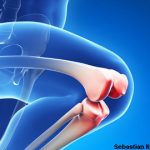“We need to identify those patients and infections that can be treated with implant retention strategies vs. single-stage exchange surgeries vs. classical two-stage exchange surgeries,” Dr. McLawhorn says. “We are also exploring the necessary regimens of parenteral and/or oral antibiotic treatments.”
To manage patients who already have an implant infection, Dr. Keroack points to two options: chronic suppressive antibiotics and retaining the implant vs. removing the implant, treating the infection and reimplantation. “[Although] suppressive antibiotics carry less morbidity, we lack data regarding which infections are most appropriate for suppression and which require removal and reimplantation,” he says. Additionally, acute bacterial infections that can become systemic need to be rapidly identified and treated to prevent seeding of the implant.
Improvements to Implant Designs
Dr. McLawhorn believes that eventually implants will be able to resist infection. Specifically, implant surfaces will disrupt the process by which bacteria form biofilm, which is a major problem in treating periprosthetic joint infections.
Other Areas
The collection of patient-reported outcome measures (PROMs), such the KOOS JR., is another important area. “In the literature, PROMs have come to the forefront in terms of assessing treatment success for nonsurgical management of arthritis and also for primary joint replacement,” Dr. McLawhorn says.
The measuring sticks for revision surgery are still less patient focused and more focused on objective treatment outcomes, such as re-operation. “[Although] the latter is certainly an outcome of interest to patients, room for improvement exists in terms of identifying and measuring other outcomes that patients may rank as being important to treatment success,” Dr. McLawhorn concludes.
Regarding room for improvement, Dr. Keroack says the subjective benefit in terms of pain control, function and overall satisfaction with primary total knee replacement surgery will help enable rheumatologists to counsel patients on what to expect from a total knee replacement. “[Although] it is critical that the radiograph indicate a successful procedure and the range of motion is optimal, what a patient really wants to know is, ‘What percent of patients are happy with their implant?’” he concludes. “Ideally KOOS JR will give us the data to show accurate outcomes so we can relay this data to potential candidates, giving them insight into what they can expect.”
Karen Appold is a medical writer in Pennsylvania.
References
- Kurtz S, Ong K, Lau E, et al. Projections of primary and revision hip and knee arthroplasty in the United States from 2005 to 2030. J Bone Joint Surg Am. 2007 Apr;89(4):780–785.
- Flegal KM, Kruszon-Moran D, Carroll MD, et al. Trends in obesity among adults in the United States, 2005 to 2014. JAMA. 2016 Jun 7;315(21):2284–2291.
- U.S. Department of Health & Human Services, Agency for Healthcare Research and Quality. HCUPnet, Healthcare Cost and Utilization Project. 2017.
- AAHKS Patient and Public Relations Committee and the AAHKS Evidence Based Medicine Committee. Total knee replacement. American Association of Hip and Knee Surgeons. 2017.
- Hospital for Special Surgery. News release: Hospital for Special Surgery presents data validating shorter, more patient friendly outcomes assessment for revision knee replacement. 2017 Mar 14.
- U.S. National Institutes of Health. Study record detail: One stage versus two stage for periprosthetic hip and knee infection. ClinicalTrials.gov. 2017 Feb.

